Leadership Styles in Public Health: A Case Study of Mrs. Helen
VerifiedAdded on 2021/09/09
|10
|2766
|82
Case Study
AI Summary
This case study delves into the leadership of Mrs. Helen, a General Health Practitioner in Warnambool, focusing on her role as a leader in a public health awareness program. The analysis explores her leadership style, particularly in light of her introverted nature and the challenges she faces in effectively communicating with and leading a team of ten individuals. The study assesses Mrs. Helen's leadership qualities, including her communication skills, ability to manage resources, and capacity to improve existing services. The case study proposes transformational leadership as a suitable approach for Mrs. Helen, emphasizing its strengths in motivating team members and fostering positive changes. Furthermore, the study identifies potential gaps in her leadership, such as communication skills, and suggests strategies for improvement. The case study provides valuable insights into the application of leadership principles within a healthcare setting and highlights the importance of adapting leadership styles to individual strengths and weaknesses.
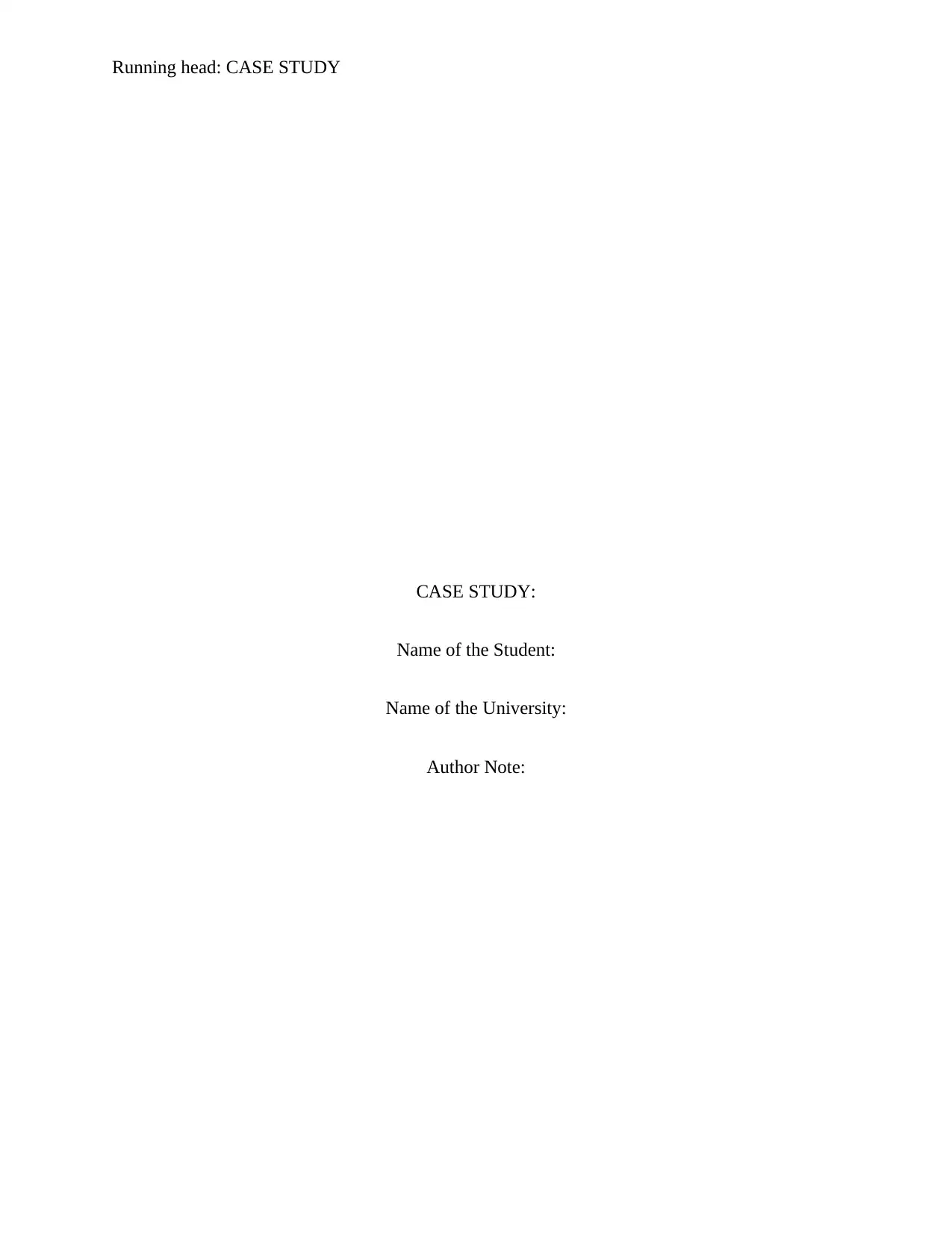
Running head: CASE STUDY
CASE STUDY:
Name of the Student:
Name of the University:
Author Note:
CASE STUDY:
Name of the Student:
Name of the University:
Author Note:
Paraphrase This Document
Need a fresh take? Get an instant paraphrase of this document with our AI Paraphraser
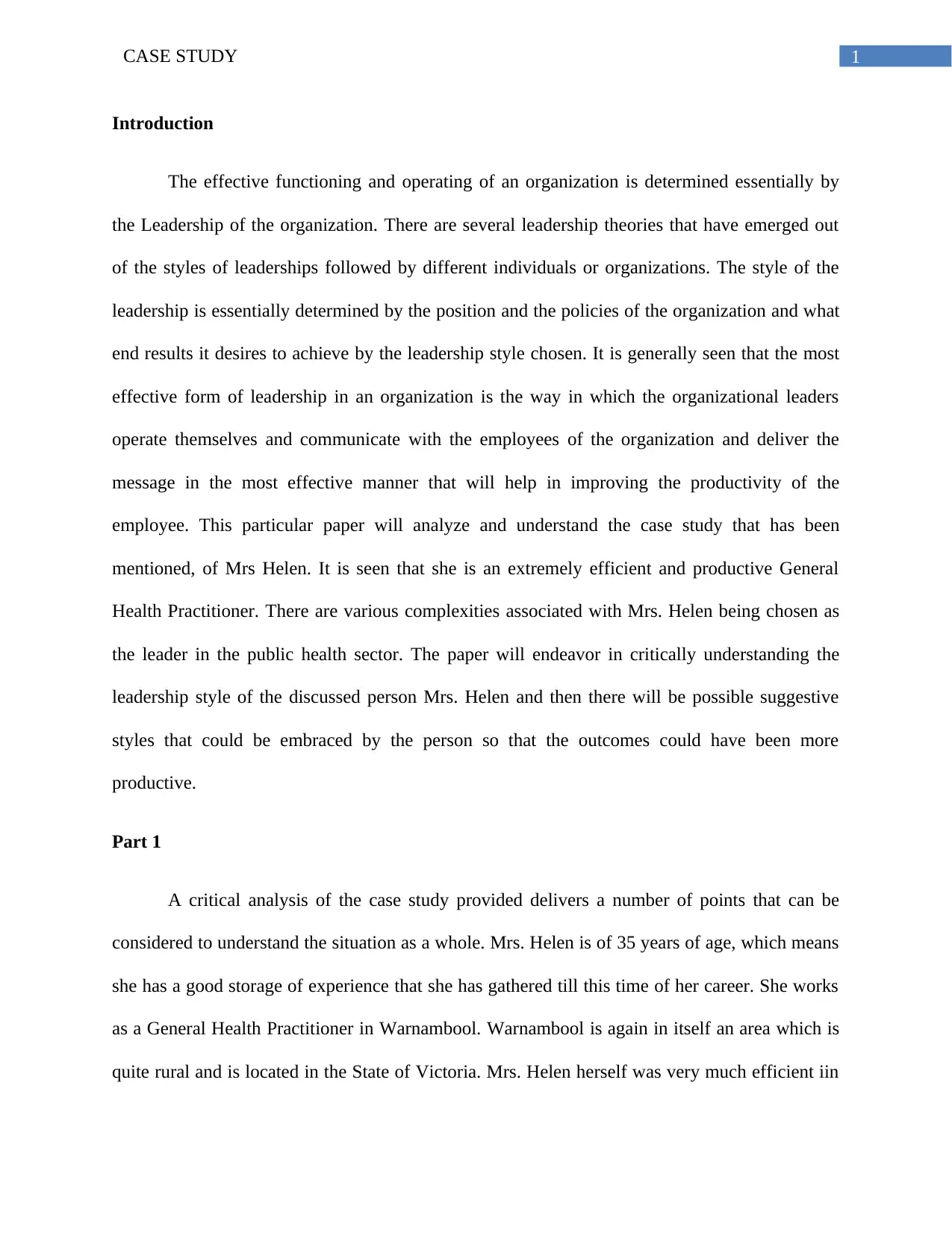
1CASE STUDY
Introduction
The effective functioning and operating of an organization is determined essentially by
the Leadership of the organization. There are several leadership theories that have emerged out
of the styles of leaderships followed by different individuals or organizations. The style of the
leadership is essentially determined by the position and the policies of the organization and what
end results it desires to achieve by the leadership style chosen. It is generally seen that the most
effective form of leadership in an organization is the way in which the organizational leaders
operate themselves and communicate with the employees of the organization and deliver the
message in the most effective manner that will help in improving the productivity of the
employee. This particular paper will analyze and understand the case study that has been
mentioned, of Mrs Helen. It is seen that she is an extremely efficient and productive General
Health Practitioner. There are various complexities associated with Mrs. Helen being chosen as
the leader in the public health sector. The paper will endeavor in critically understanding the
leadership style of the discussed person Mrs. Helen and then there will be possible suggestive
styles that could be embraced by the person so that the outcomes could have been more
productive.
Part 1
A critical analysis of the case study provided delivers a number of points that can be
considered to understand the situation as a whole. Mrs. Helen is of 35 years of age, which means
she has a good storage of experience that she has gathered till this time of her career. She works
as a General Health Practitioner in Warnambool. Warnambool is again in itself an area which is
quite rural and is located in the State of Victoria. Mrs. Helen herself was very much efficient iin
Introduction
The effective functioning and operating of an organization is determined essentially by
the Leadership of the organization. There are several leadership theories that have emerged out
of the styles of leaderships followed by different individuals or organizations. The style of the
leadership is essentially determined by the position and the policies of the organization and what
end results it desires to achieve by the leadership style chosen. It is generally seen that the most
effective form of leadership in an organization is the way in which the organizational leaders
operate themselves and communicate with the employees of the organization and deliver the
message in the most effective manner that will help in improving the productivity of the
employee. This particular paper will analyze and understand the case study that has been
mentioned, of Mrs Helen. It is seen that she is an extremely efficient and productive General
Health Practitioner. There are various complexities associated with Mrs. Helen being chosen as
the leader in the public health sector. The paper will endeavor in critically understanding the
leadership style of the discussed person Mrs. Helen and then there will be possible suggestive
styles that could be embraced by the person so that the outcomes could have been more
productive.
Part 1
A critical analysis of the case study provided delivers a number of points that can be
considered to understand the situation as a whole. Mrs. Helen is of 35 years of age, which means
she has a good storage of experience that she has gathered till this time of her career. She works
as a General Health Practitioner in Warnambool. Warnambool is again in itself an area which is
quite rural and is located in the State of Victoria. Mrs. Helen herself was very much efficient iin
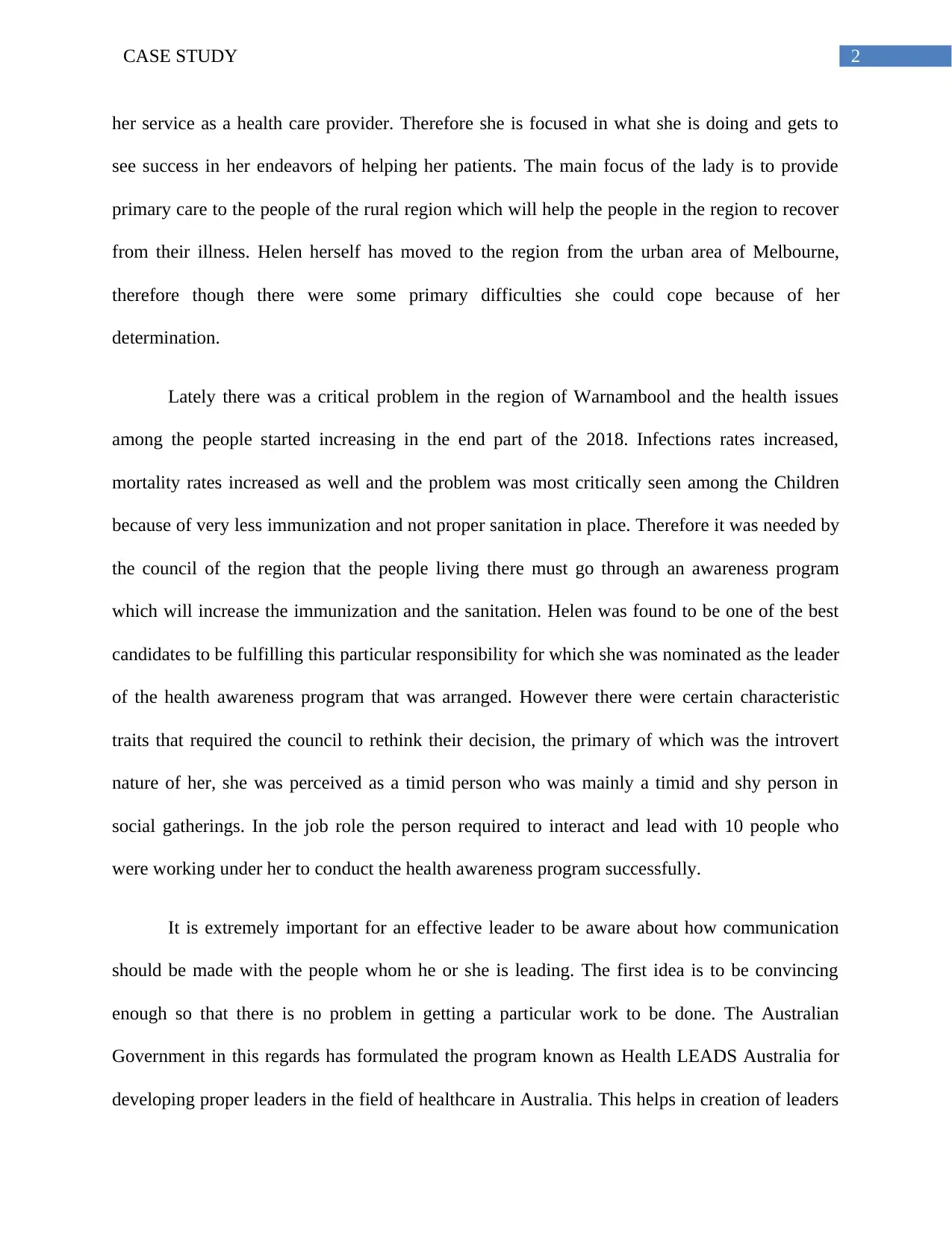
2CASE STUDY
her service as a health care provider. Therefore she is focused in what she is doing and gets to
see success in her endeavors of helping her patients. The main focus of the lady is to provide
primary care to the people of the rural region which will help the people in the region to recover
from their illness. Helen herself has moved to the region from the urban area of Melbourne,
therefore though there were some primary difficulties she could cope because of her
determination.
Lately there was a critical problem in the region of Warnambool and the health issues
among the people started increasing in the end part of the 2018. Infections rates increased,
mortality rates increased as well and the problem was most critically seen among the Children
because of very less immunization and not proper sanitation in place. Therefore it was needed by
the council of the region that the people living there must go through an awareness program
which will increase the immunization and the sanitation. Helen was found to be one of the best
candidates to be fulfilling this particular responsibility for which she was nominated as the leader
of the health awareness program that was arranged. However there were certain characteristic
traits that required the council to rethink their decision, the primary of which was the introvert
nature of her, she was perceived as a timid person who was mainly a timid and shy person in
social gatherings. In the job role the person required to interact and lead with 10 people who
were working under her to conduct the health awareness program successfully.
It is extremely important for an effective leader to be aware about how communication
should be made with the people whom he or she is leading. The first idea is to be convincing
enough so that there is no problem in getting a particular work to be done. The Australian
Government in this regards has formulated the program known as Health LEADS Australia for
developing proper leaders in the field of healthcare in Australia. This helps in creation of leaders
her service as a health care provider. Therefore she is focused in what she is doing and gets to
see success in her endeavors of helping her patients. The main focus of the lady is to provide
primary care to the people of the rural region which will help the people in the region to recover
from their illness. Helen herself has moved to the region from the urban area of Melbourne,
therefore though there were some primary difficulties she could cope because of her
determination.
Lately there was a critical problem in the region of Warnambool and the health issues
among the people started increasing in the end part of the 2018. Infections rates increased,
mortality rates increased as well and the problem was most critically seen among the Children
because of very less immunization and not proper sanitation in place. Therefore it was needed by
the council of the region that the people living there must go through an awareness program
which will increase the immunization and the sanitation. Helen was found to be one of the best
candidates to be fulfilling this particular responsibility for which she was nominated as the leader
of the health awareness program that was arranged. However there were certain characteristic
traits that required the council to rethink their decision, the primary of which was the introvert
nature of her, she was perceived as a timid person who was mainly a timid and shy person in
social gatherings. In the job role the person required to interact and lead with 10 people who
were working under her to conduct the health awareness program successfully.
It is extremely important for an effective leader to be aware about how communication
should be made with the people whom he or she is leading. The first idea is to be convincing
enough so that there is no problem in getting a particular work to be done. The Australian
Government in this regards has formulated the program known as Health LEADS Australia for
developing proper leaders in the field of healthcare in Australia. This helps in creation of leaders
⊘ This is a preview!⊘
Do you want full access?
Subscribe today to unlock all pages.

Trusted by 1+ million students worldwide
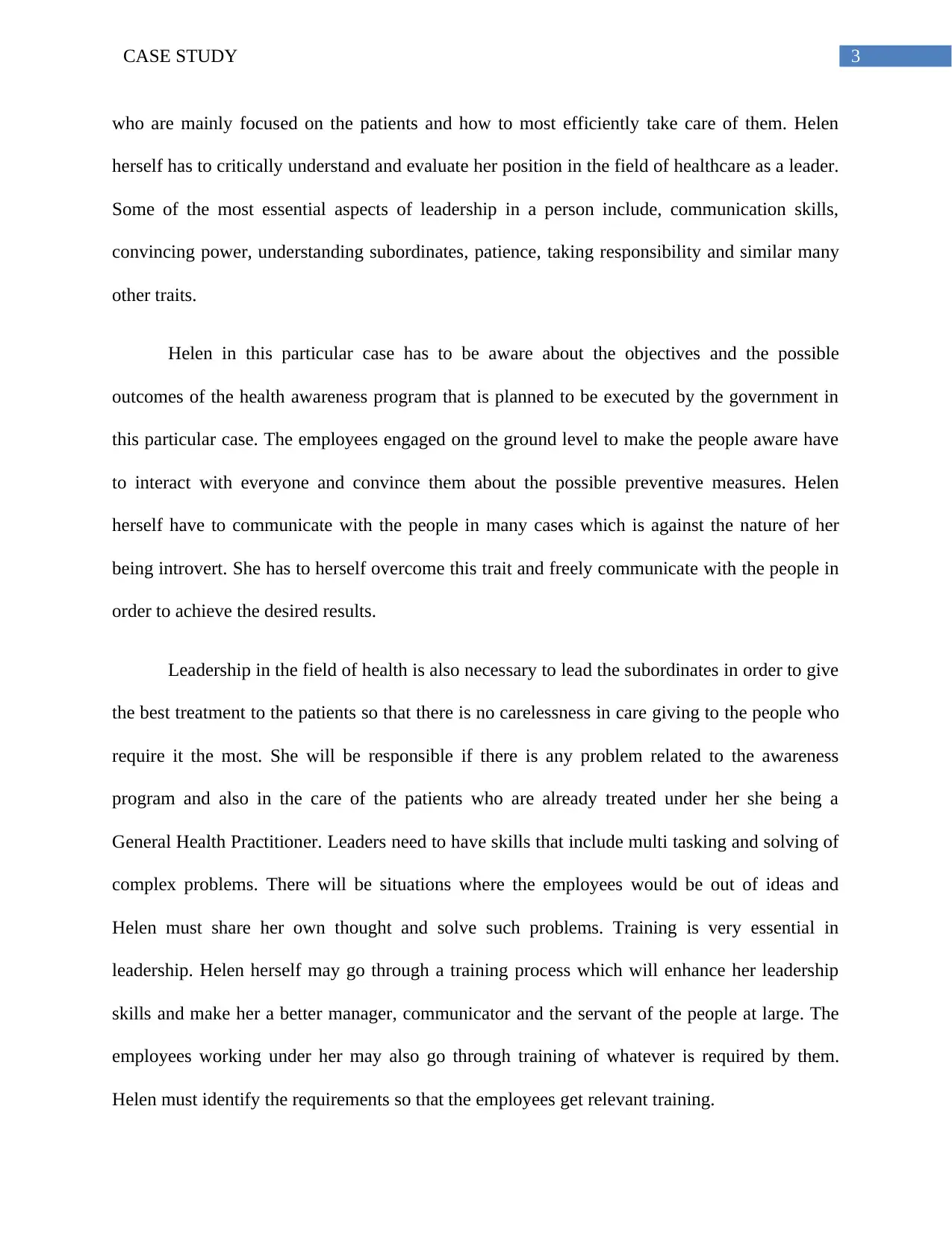
3CASE STUDY
who are mainly focused on the patients and how to most efficiently take care of them. Helen
herself has to critically understand and evaluate her position in the field of healthcare as a leader.
Some of the most essential aspects of leadership in a person include, communication skills,
convincing power, understanding subordinates, patience, taking responsibility and similar many
other traits.
Helen in this particular case has to be aware about the objectives and the possible
outcomes of the health awareness program that is planned to be executed by the government in
this particular case. The employees engaged on the ground level to make the people aware have
to interact with everyone and convince them about the possible preventive measures. Helen
herself have to communicate with the people in many cases which is against the nature of her
being introvert. She has to herself overcome this trait and freely communicate with the people in
order to achieve the desired results.
Leadership in the field of health is also necessary to lead the subordinates in order to give
the best treatment to the patients so that there is no carelessness in care giving to the people who
require it the most. She will be responsible if there is any problem related to the awareness
program and also in the care of the patients who are already treated under her she being a
General Health Practitioner. Leaders need to have skills that include multi tasking and solving of
complex problems. There will be situations where the employees would be out of ideas and
Helen must share her own thought and solve such problems. Training is very essential in
leadership. Helen herself may go through a training process which will enhance her leadership
skills and make her a better manager, communicator and the servant of the people at large. The
employees working under her may also go through training of whatever is required by them.
Helen must identify the requirements so that the employees get relevant training.
who are mainly focused on the patients and how to most efficiently take care of them. Helen
herself has to critically understand and evaluate her position in the field of healthcare as a leader.
Some of the most essential aspects of leadership in a person include, communication skills,
convincing power, understanding subordinates, patience, taking responsibility and similar many
other traits.
Helen in this particular case has to be aware about the objectives and the possible
outcomes of the health awareness program that is planned to be executed by the government in
this particular case. The employees engaged on the ground level to make the people aware have
to interact with everyone and convince them about the possible preventive measures. Helen
herself have to communicate with the people in many cases which is against the nature of her
being introvert. She has to herself overcome this trait and freely communicate with the people in
order to achieve the desired results.
Leadership in the field of health is also necessary to lead the subordinates in order to give
the best treatment to the patients so that there is no carelessness in care giving to the people who
require it the most. She will be responsible if there is any problem related to the awareness
program and also in the care of the patients who are already treated under her she being a
General Health Practitioner. Leaders need to have skills that include multi tasking and solving of
complex problems. There will be situations where the employees would be out of ideas and
Helen must share her own thought and solve such problems. Training is very essential in
leadership. Helen herself may go through a training process which will enhance her leadership
skills and make her a better manager, communicator and the servant of the people at large. The
employees working under her may also go through training of whatever is required by them.
Helen must identify the requirements so that the employees get relevant training.
Paraphrase This Document
Need a fresh take? Get an instant paraphrase of this document with our AI Paraphraser
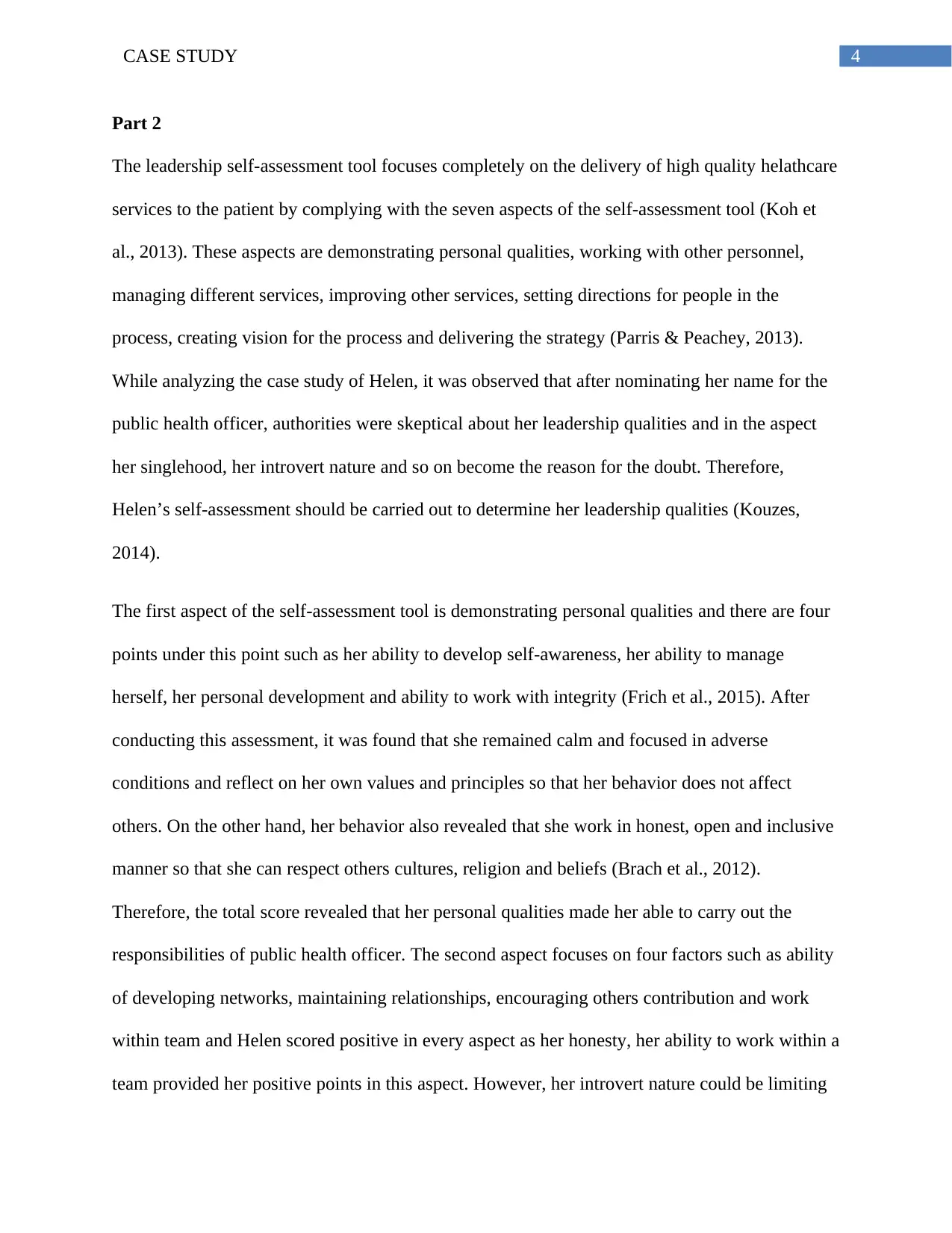
4CASE STUDY
Part 2
The leadership self-assessment tool focuses completely on the delivery of high quality helathcare
services to the patient by complying with the seven aspects of the self-assessment tool (Koh et
al., 2013). These aspects are demonstrating personal qualities, working with other personnel,
managing different services, improving other services, setting directions for people in the
process, creating vision for the process and delivering the strategy (Parris & Peachey, 2013).
While analyzing the case study of Helen, it was observed that after nominating her name for the
public health officer, authorities were skeptical about her leadership qualities and in the aspect
her singlehood, her introvert nature and so on become the reason for the doubt. Therefore,
Helen’s self-assessment should be carried out to determine her leadership qualities (Kouzes,
2014).
The first aspect of the self-assessment tool is demonstrating personal qualities and there are four
points under this point such as her ability to develop self-awareness, her ability to manage
herself, her personal development and ability to work with integrity (Frich et al., 2015). After
conducting this assessment, it was found that she remained calm and focused in adverse
conditions and reflect on her own values and principles so that her behavior does not affect
others. On the other hand, her behavior also revealed that she work in honest, open and inclusive
manner so that she can respect others cultures, religion and beliefs (Brach et al., 2012).
Therefore, the total score revealed that her personal qualities made her able to carry out the
responsibilities of public health officer. The second aspect focuses on four factors such as ability
of developing networks, maintaining relationships, encouraging others contribution and work
within team and Helen scored positive in every aspect as her honesty, her ability to work within a
team provided her positive points in this aspect. However, her introvert nature could be limiting
Part 2
The leadership self-assessment tool focuses completely on the delivery of high quality helathcare
services to the patient by complying with the seven aspects of the self-assessment tool (Koh et
al., 2013). These aspects are demonstrating personal qualities, working with other personnel,
managing different services, improving other services, setting directions for people in the
process, creating vision for the process and delivering the strategy (Parris & Peachey, 2013).
While analyzing the case study of Helen, it was observed that after nominating her name for the
public health officer, authorities were skeptical about her leadership qualities and in the aspect
her singlehood, her introvert nature and so on become the reason for the doubt. Therefore,
Helen’s self-assessment should be carried out to determine her leadership qualities (Kouzes,
2014).
The first aspect of the self-assessment tool is demonstrating personal qualities and there are four
points under this point such as her ability to develop self-awareness, her ability to manage
herself, her personal development and ability to work with integrity (Frich et al., 2015). After
conducting this assessment, it was found that she remained calm and focused in adverse
conditions and reflect on her own values and principles so that her behavior does not affect
others. On the other hand, her behavior also revealed that she work in honest, open and inclusive
manner so that she can respect others cultures, religion and beliefs (Brach et al., 2012).
Therefore, the total score revealed that her personal qualities made her able to carry out the
responsibilities of public health officer. The second aspect focuses on four factors such as ability
of developing networks, maintaining relationships, encouraging others contribution and work
within team and Helen scored positive in every aspect as her honesty, her ability to work within a
team provided her positive points in this aspect. However, her introvert nature could be limiting
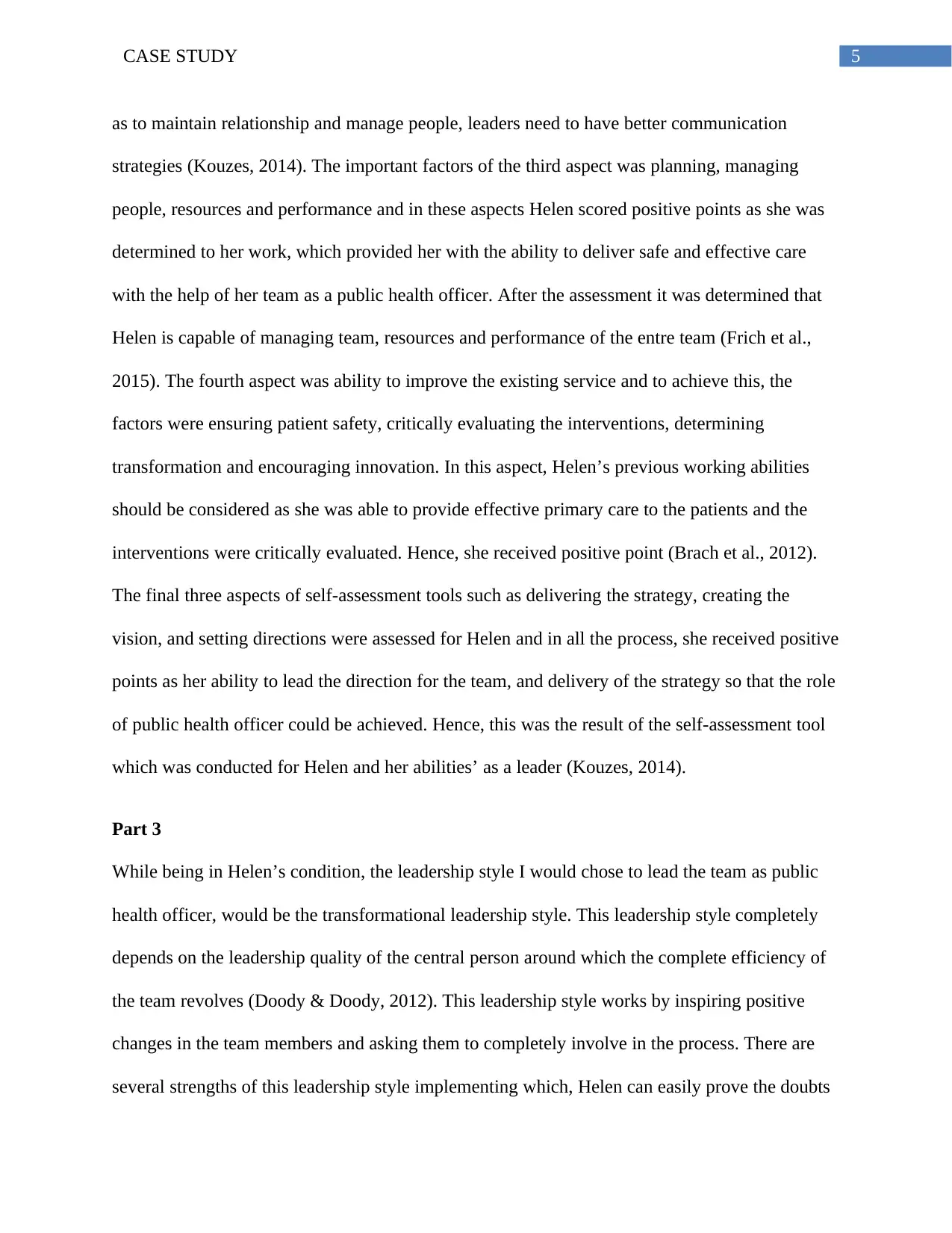
5CASE STUDY
as to maintain relationship and manage people, leaders need to have better communication
strategies (Kouzes, 2014). The important factors of the third aspect was planning, managing
people, resources and performance and in these aspects Helen scored positive points as she was
determined to her work, which provided her with the ability to deliver safe and effective care
with the help of her team as a public health officer. After the assessment it was determined that
Helen is capable of managing team, resources and performance of the entre team (Frich et al.,
2015). The fourth aspect was ability to improve the existing service and to achieve this, the
factors were ensuring patient safety, critically evaluating the interventions, determining
transformation and encouraging innovation. In this aspect, Helen’s previous working abilities
should be considered as she was able to provide effective primary care to the patients and the
interventions were critically evaluated. Hence, she received positive point (Brach et al., 2012).
The final three aspects of self-assessment tools such as delivering the strategy, creating the
vision, and setting directions were assessed for Helen and in all the process, she received positive
points as her ability to lead the direction for the team, and delivery of the strategy so that the role
of public health officer could be achieved. Hence, this was the result of the self-assessment tool
which was conducted for Helen and her abilities’ as a leader (Kouzes, 2014).
Part 3
While being in Helen’s condition, the leadership style I would chose to lead the team as public
health officer, would be the transformational leadership style. This leadership style completely
depends on the leadership quality of the central person around which the complete efficiency of
the team revolves (Doody & Doody, 2012). This leadership style works by inspiring positive
changes in the team members and asking them to completely involve in the process. There are
several strengths of this leadership style implementing which, Helen can easily prove the doubts
as to maintain relationship and manage people, leaders need to have better communication
strategies (Kouzes, 2014). The important factors of the third aspect was planning, managing
people, resources and performance and in these aspects Helen scored positive points as she was
determined to her work, which provided her with the ability to deliver safe and effective care
with the help of her team as a public health officer. After the assessment it was determined that
Helen is capable of managing team, resources and performance of the entre team (Frich et al.,
2015). The fourth aspect was ability to improve the existing service and to achieve this, the
factors were ensuring patient safety, critically evaluating the interventions, determining
transformation and encouraging innovation. In this aspect, Helen’s previous working abilities
should be considered as she was able to provide effective primary care to the patients and the
interventions were critically evaluated. Hence, she received positive point (Brach et al., 2012).
The final three aspects of self-assessment tools such as delivering the strategy, creating the
vision, and setting directions were assessed for Helen and in all the process, she received positive
points as her ability to lead the direction for the team, and delivery of the strategy so that the role
of public health officer could be achieved. Hence, this was the result of the self-assessment tool
which was conducted for Helen and her abilities’ as a leader (Kouzes, 2014).
Part 3
While being in Helen’s condition, the leadership style I would chose to lead the team as public
health officer, would be the transformational leadership style. This leadership style completely
depends on the leadership quality of the central person around which the complete efficiency of
the team revolves (Doody & Doody, 2012). This leadership style works by inspiring positive
changes in the team members and asking them to completely involve in the process. There are
several strengths of this leadership style implementing which, Helen can easily prove the doubts
⊘ This is a preview!⊘
Do you want full access?
Subscribe today to unlock all pages.

Trusted by 1+ million students worldwide
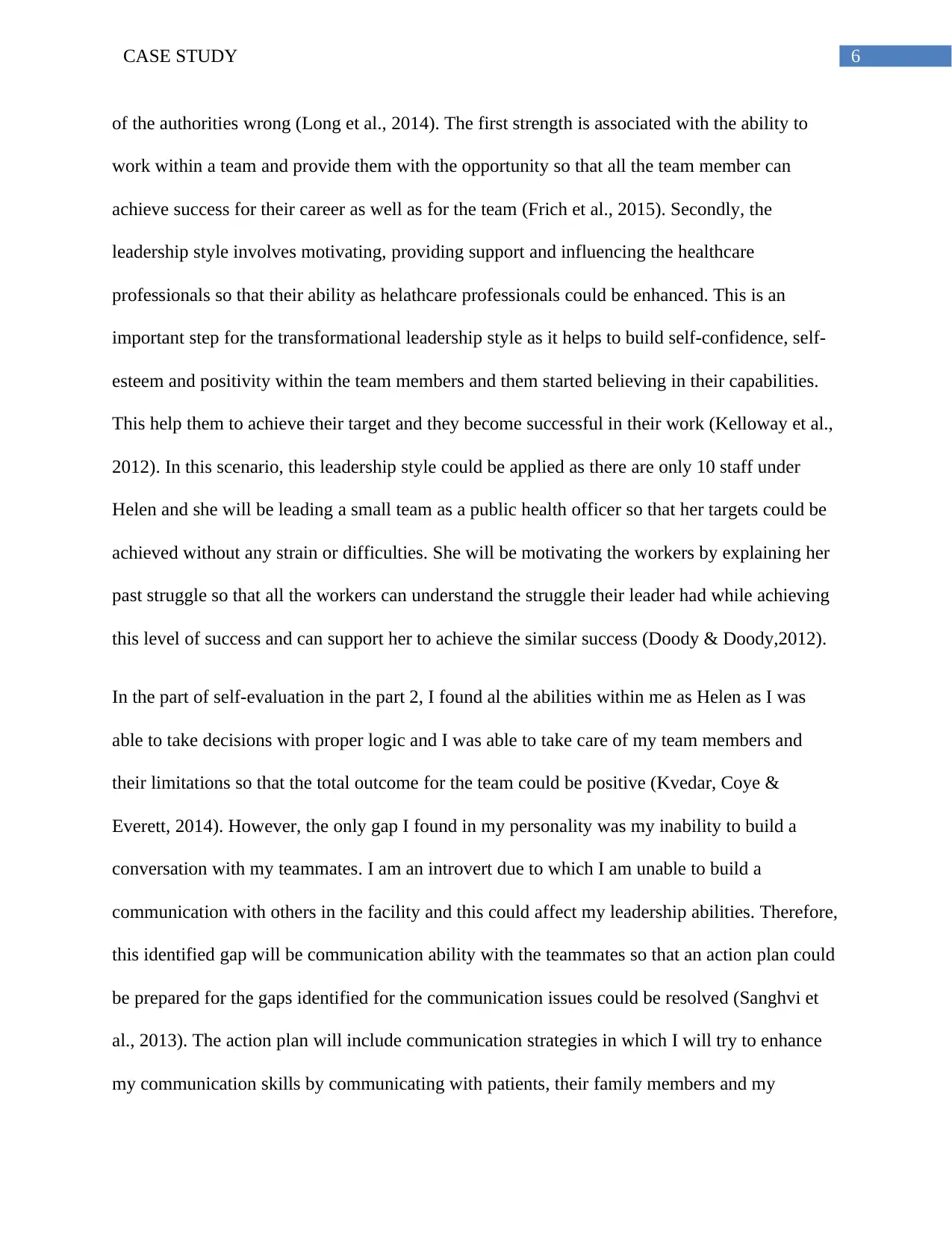
6CASE STUDY
of the authorities wrong (Long et al., 2014). The first strength is associated with the ability to
work within a team and provide them with the opportunity so that all the team member can
achieve success for their career as well as for the team (Frich et al., 2015). Secondly, the
leadership style involves motivating, providing support and influencing the healthcare
professionals so that their ability as helathcare professionals could be enhanced. This is an
important step for the transformational leadership style as it helps to build self-confidence, self-
esteem and positivity within the team members and them started believing in their capabilities.
This help them to achieve their target and they become successful in their work (Kelloway et al.,
2012). In this scenario, this leadership style could be applied as there are only 10 staff under
Helen and she will be leading a small team as a public health officer so that her targets could be
achieved without any strain or difficulties. She will be motivating the workers by explaining her
past struggle so that all the workers can understand the struggle their leader had while achieving
this level of success and can support her to achieve the similar success (Doody & Doody,2012).
In the part of self-evaluation in the part 2, I found al the abilities within me as Helen as I was
able to take decisions with proper logic and I was able to take care of my team members and
their limitations so that the total outcome for the team could be positive (Kvedar, Coye &
Everett, 2014). However, the only gap I found in my personality was my inability to build a
conversation with my teammates. I am an introvert due to which I am unable to build a
communication with others in the facility and this could affect my leadership abilities. Therefore,
this identified gap will be communication ability with the teammates so that an action plan could
be prepared for the gaps identified for the communication issues could be resolved (Sanghvi et
al., 2013). The action plan will include communication strategies in which I will try to enhance
my communication skills by communicating with patients, their family members and my
of the authorities wrong (Long et al., 2014). The first strength is associated with the ability to
work within a team and provide them with the opportunity so that all the team member can
achieve success for their career as well as for the team (Frich et al., 2015). Secondly, the
leadership style involves motivating, providing support and influencing the healthcare
professionals so that their ability as helathcare professionals could be enhanced. This is an
important step for the transformational leadership style as it helps to build self-confidence, self-
esteem and positivity within the team members and them started believing in their capabilities.
This help them to achieve their target and they become successful in their work (Kelloway et al.,
2012). In this scenario, this leadership style could be applied as there are only 10 staff under
Helen and she will be leading a small team as a public health officer so that her targets could be
achieved without any strain or difficulties. She will be motivating the workers by explaining her
past struggle so that all the workers can understand the struggle their leader had while achieving
this level of success and can support her to achieve the similar success (Doody & Doody,2012).
In the part of self-evaluation in the part 2, I found al the abilities within me as Helen as I was
able to take decisions with proper logic and I was able to take care of my team members and
their limitations so that the total outcome for the team could be positive (Kvedar, Coye &
Everett, 2014). However, the only gap I found in my personality was my inability to build a
conversation with my teammates. I am an introvert due to which I am unable to build a
communication with others in the facility and this could affect my leadership abilities. Therefore,
this identified gap will be communication ability with the teammates so that an action plan could
be prepared for the gaps identified for the communication issues could be resolved (Sanghvi et
al., 2013). The action plan will include communication strategies in which I will try to enhance
my communication skills by communicating with patients, their family members and my
Paraphrase This Document
Need a fresh take? Get an instant paraphrase of this document with our AI Paraphraser
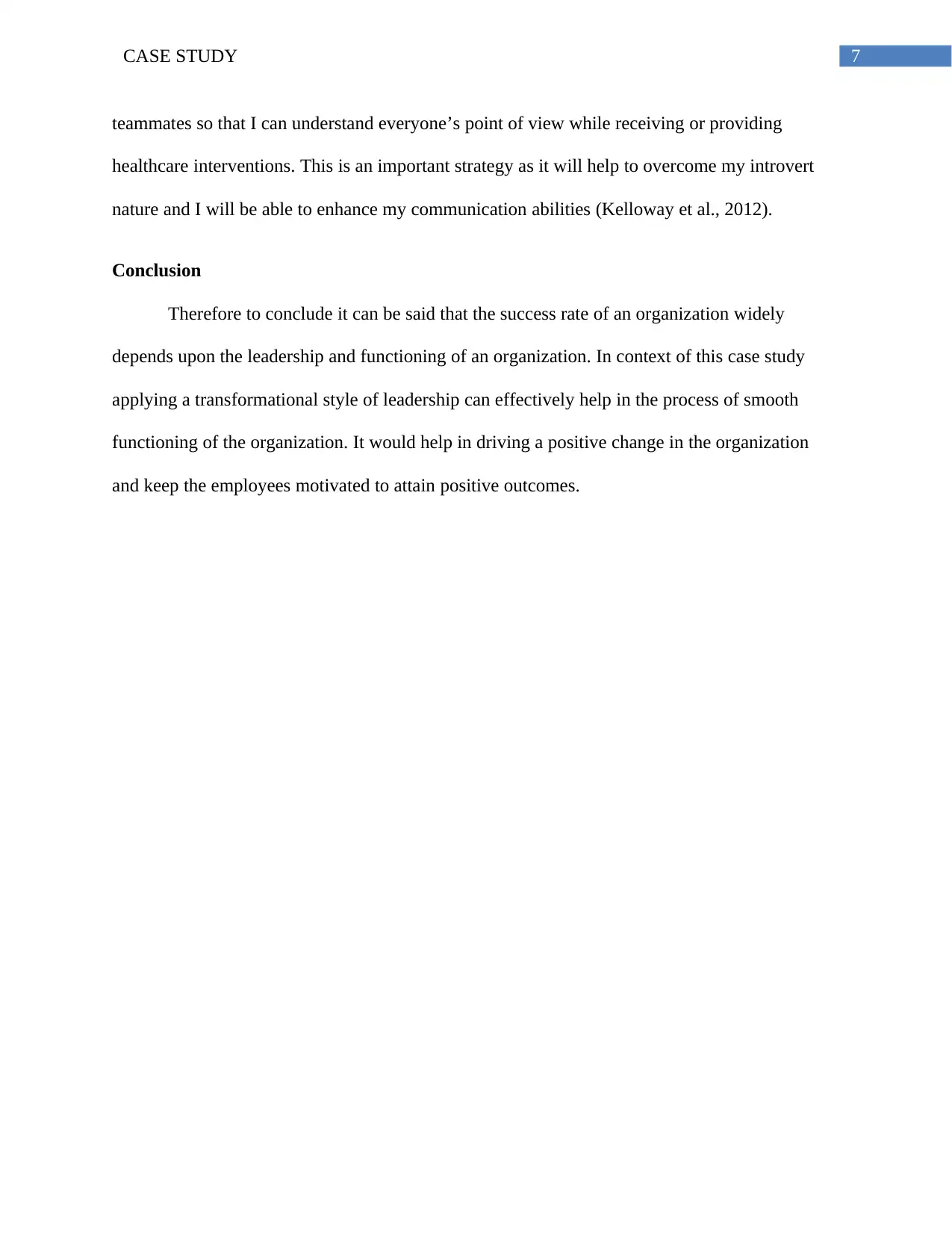
7CASE STUDY
teammates so that I can understand everyone’s point of view while receiving or providing
healthcare interventions. This is an important strategy as it will help to overcome my introvert
nature and I will be able to enhance my communication abilities (Kelloway et al., 2012).
Conclusion
Therefore to conclude it can be said that the success rate of an organization widely
depends upon the leadership and functioning of an organization. In context of this case study
applying a transformational style of leadership can effectively help in the process of smooth
functioning of the organization. It would help in driving a positive change in the organization
and keep the employees motivated to attain positive outcomes.
teammates so that I can understand everyone’s point of view while receiving or providing
healthcare interventions. This is an important strategy as it will help to overcome my introvert
nature and I will be able to enhance my communication abilities (Kelloway et al., 2012).
Conclusion
Therefore to conclude it can be said that the success rate of an organization widely
depends upon the leadership and functioning of an organization. In context of this case study
applying a transformational style of leadership can effectively help in the process of smooth
functioning of the organization. It would help in driving a positive change in the organization
and keep the employees motivated to attain positive outcomes.
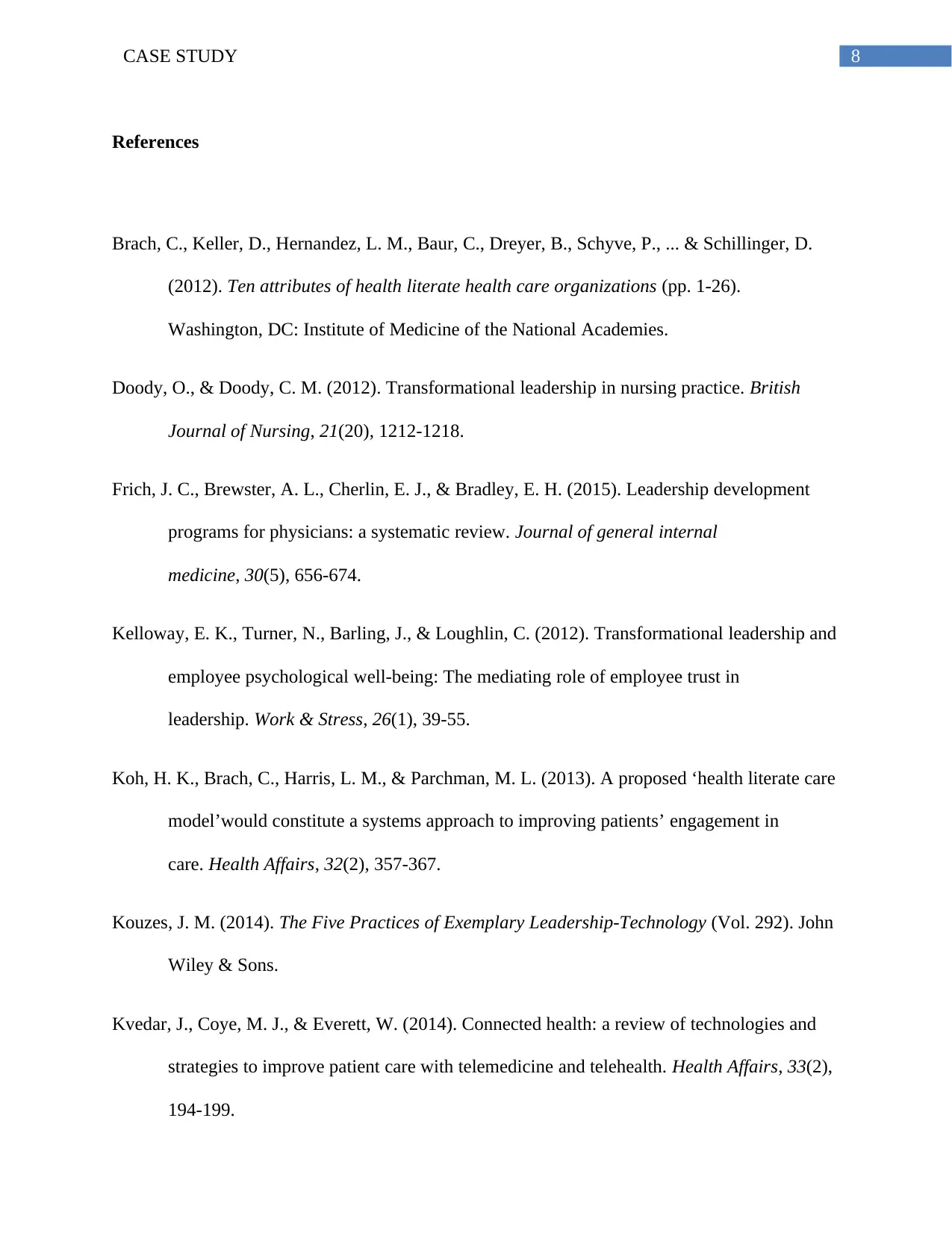
8CASE STUDY
References
Brach, C., Keller, D., Hernandez, L. M., Baur, C., Dreyer, B., Schyve, P., ... & Schillinger, D.
(2012). Ten attributes of health literate health care organizations (pp. 1-26).
Washington, DC: Institute of Medicine of the National Academies.
Doody, O., & Doody, C. M. (2012). Transformational leadership in nursing practice. British
Journal of Nursing, 21(20), 1212-1218.
Frich, J. C., Brewster, A. L., Cherlin, E. J., & Bradley, E. H. (2015). Leadership development
programs for physicians: a systematic review. Journal of general internal
medicine, 30(5), 656-674.
Kelloway, E. K., Turner, N., Barling, J., & Loughlin, C. (2012). Transformational leadership and
employee psychological well-being: The mediating role of employee trust in
leadership. Work & Stress, 26(1), 39-55.
Koh, H. K., Brach, C., Harris, L. M., & Parchman, M. L. (2013). A proposed ‘health literate care
model’would constitute a systems approach to improving patients’ engagement in
care. Health Affairs, 32(2), 357-367.
Kouzes, J. M. (2014). The Five Practices of Exemplary Leadership-Technology (Vol. 292). John
Wiley & Sons.
Kvedar, J., Coye, M. J., & Everett, W. (2014). Connected health: a review of technologies and
strategies to improve patient care with telemedicine and telehealth. Health Affairs, 33(2),
194-199.
References
Brach, C., Keller, D., Hernandez, L. M., Baur, C., Dreyer, B., Schyve, P., ... & Schillinger, D.
(2012). Ten attributes of health literate health care organizations (pp. 1-26).
Washington, DC: Institute of Medicine of the National Academies.
Doody, O., & Doody, C. M. (2012). Transformational leadership in nursing practice. British
Journal of Nursing, 21(20), 1212-1218.
Frich, J. C., Brewster, A. L., Cherlin, E. J., & Bradley, E. H. (2015). Leadership development
programs for physicians: a systematic review. Journal of general internal
medicine, 30(5), 656-674.
Kelloway, E. K., Turner, N., Barling, J., & Loughlin, C. (2012). Transformational leadership and
employee psychological well-being: The mediating role of employee trust in
leadership. Work & Stress, 26(1), 39-55.
Koh, H. K., Brach, C., Harris, L. M., & Parchman, M. L. (2013). A proposed ‘health literate care
model’would constitute a systems approach to improving patients’ engagement in
care. Health Affairs, 32(2), 357-367.
Kouzes, J. M. (2014). The Five Practices of Exemplary Leadership-Technology (Vol. 292). John
Wiley & Sons.
Kvedar, J., Coye, M. J., & Everett, W. (2014). Connected health: a review of technologies and
strategies to improve patient care with telemedicine and telehealth. Health Affairs, 33(2),
194-199.
⊘ This is a preview!⊘
Do you want full access?
Subscribe today to unlock all pages.

Trusted by 1+ million students worldwide
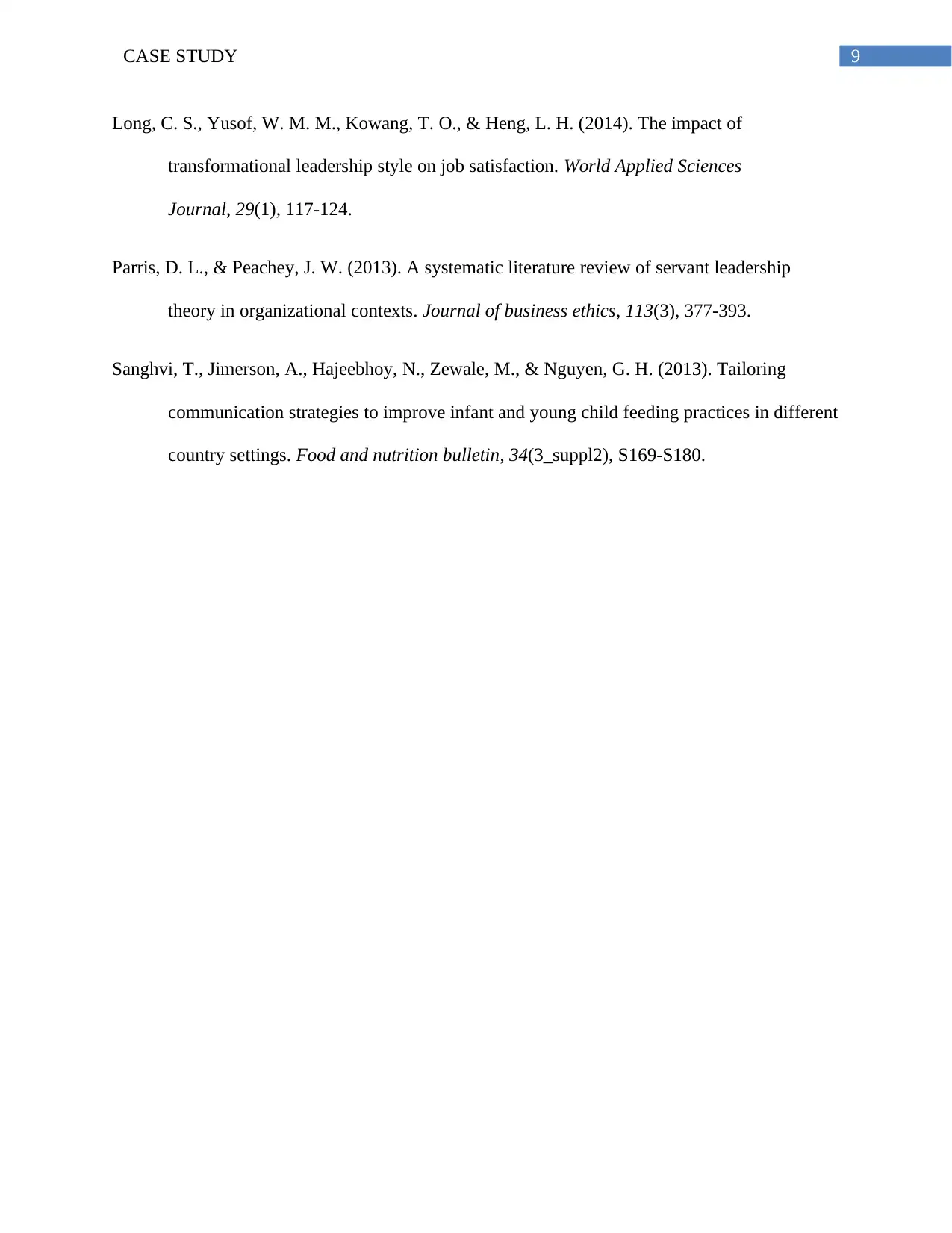
9CASE STUDY
Long, C. S., Yusof, W. M. M., Kowang, T. O., & Heng, L. H. (2014). The impact of
transformational leadership style on job satisfaction. World Applied Sciences
Journal, 29(1), 117-124.
Parris, D. L., & Peachey, J. W. (2013). A systematic literature review of servant leadership
theory in organizational contexts. Journal of business ethics, 113(3), 377-393.
Sanghvi, T., Jimerson, A., Hajeebhoy, N., Zewale, M., & Nguyen, G. H. (2013). Tailoring
communication strategies to improve infant and young child feeding practices in different
country settings. Food and nutrition bulletin, 34(3_suppl2), S169-S180.
Long, C. S., Yusof, W. M. M., Kowang, T. O., & Heng, L. H. (2014). The impact of
transformational leadership style on job satisfaction. World Applied Sciences
Journal, 29(1), 117-124.
Parris, D. L., & Peachey, J. W. (2013). A systematic literature review of servant leadership
theory in organizational contexts. Journal of business ethics, 113(3), 377-393.
Sanghvi, T., Jimerson, A., Hajeebhoy, N., Zewale, M., & Nguyen, G. H. (2013). Tailoring
communication strategies to improve infant and young child feeding practices in different
country settings. Food and nutrition bulletin, 34(3_suppl2), S169-S180.
1 out of 10
Related Documents
Your All-in-One AI-Powered Toolkit for Academic Success.
+13062052269
info@desklib.com
Available 24*7 on WhatsApp / Email
![[object Object]](/_next/static/media/star-bottom.7253800d.svg)
Unlock your academic potential
Copyright © 2020–2025 A2Z Services. All Rights Reserved. Developed and managed by ZUCOL.





